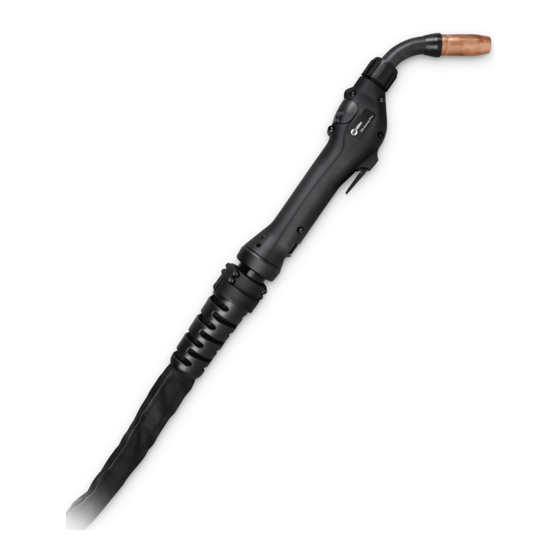Miller XR-W Aluma-Pro Plus 25 Owner's Manual - Page 5
Browse online or download pdf Owner's Manual for Welding System Miller XR-W Aluma-Pro Plus 25. Miller XR-W Aluma-Pro Plus 25 36 pages. Air and water-cooled guns

SECTION 1 −SAFETY PRECAUTIONS FOR GMAW
WELDING GUNS − READ BEFORE USING
Protect yourself and others from injury — read, follow, and save these important safety precautions and operating instructions.
1-1. Symbol Usage
DANGER! − Indicates a hazardous situation which, if
not avoided, will result in death or serious injury. The
possible hazards are shown in the adjoining symbols
or explained in the text.
Indicates a hazardous situation which, if not avoided,
could result in death or serious injury. The possible
hazards are shown in the adjoining symbols or ex-
plained in the text.
NOTICE − Indicates statements not related to personal injury.
1-2. Arc Welding Hazards
The symbols shown below are used throughout this manual
to call attention to and identify possible hazards. When you
see the symbol, watch out, and follow the related instructions
to avoid the hazard. The safety information given below is
only a summary of the more complete safety information
found in the Principal Safety Standards listed in Section 1-4,
and in welding power source Owner's Manual. Read and fol-
low all Safety Standards.
Only qualified persons should install, operate, maintain, and
repair this equipment. A qualified person is defined as one
who, by possession of a recognized degree, certificate, or
professional standing, or who by extensive knowledge, train-
ing and experience, has successfully demonstrated ability to
solve or resolve problems relating to the subject matter, the
work, or the project and has received safety training to recog-
nize and avoid the hazards involved.
During operation, keep everybody, especially children, away.
ELECTRIC SHOCK can kill.
D Always wear dry insulating gloves.
D Insulate yourself from work and ground.
D Do not touch live electrode or electrical parts.
D Replace worn, damaged, or cracked guns or cables.
D Turn off welding power source before changing contact tip or gun
parts.
D Keep all covers and handle securely in place.
FUMES AND GASES can be hazardous.
D Keep your head out of the fumes.
D Ventilate area, or use breathing device. The
recommended way to determine adequate
ventilation is to sample for the composition and quantity of fumes
and gases to which personnel are exposed.
D Read and understand the Safety Data Sheets (SDSs) and the
manufacturer's instructions for adhesives, coatings, cleaners,
consumables, coolants, degreasers, fluxes, and metals.
MOVING PARTS can injure.
D Keep away from moving parts.
D Keep away from pinch points such as drive
rolls.
.
Indicates special instructions.
This group of symbols means Warning! Watch Out! ELECTRIC
SHOCK, MOVING PARTS, and HOT PARTS hazards. Consult sym-
bols and related instructions below for necessary actions to avoid
these hazards.
WELDING can cause fire or explosion.
D Do not weld near flammable material.
D Do not weld on containers that have held com-
bustibles, or on closed containers such as
tanks, drums, or pipes unless they are properly prepared ac-
cording to AWS F4.1 and AWS A6.0 (see Safety Standards).
D Watch for fire; keep extinguisher nearby.
D Read and understand the Safety Data Sheets (SDSs) and the
manufacturer's instructions for adhesives, coatings, cleaners,
consumables, coolants, degreasers, fluxes, and metals.
BUILDUP OF GAS can injure or kill.
D Shut off compressed gas supply when not in
use.
D Always ventilate confined spaces or use ap-
proved air-supplied respirator.
ARC RAYS can burn eyes and skin.
Arc rays from the welding process produce intense
visible and invisible (ultraviolet and infrared) rays
that can burn eyes and skin. Sparks fly off from the
weld.
D Wear an approved welding helmet fitted with a proper shade of filter
lenses to protect your face and eyes from arc rays and sparks
when welding or watching (see ANSI Z49.1 and Z87.1 listed in
Safety Standards).
D Wear approved safety glasses with side shields under your
helmet.
D Use protective screens or barriers to protect others from flash,
glare and sparks; warn others not to watch the arc.
D Wear body protection made from durable, flame-resistant material
(leather, heavy cotton, wool). Body protection includes oil-free
clothing such as leather gloves, heavy shirt, cuffless trousers, high
shoes, and a cap.
HOT PARTS can burn.
D Allow gun to cool before touching.
D Do not touch hot metal.
D Protect hot metal from contact by others.
SR7 (MIG) 2020-02
OM-285555 Page 1
